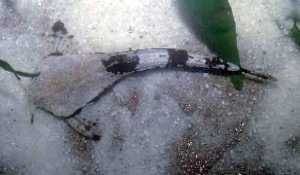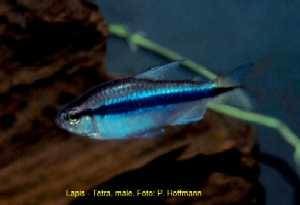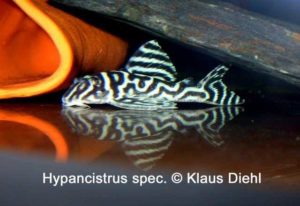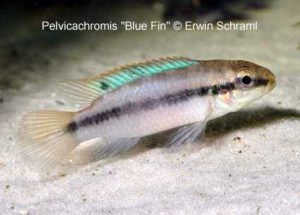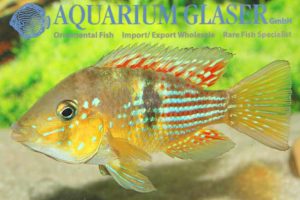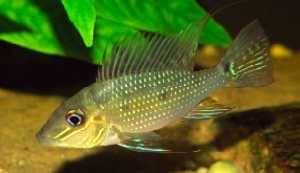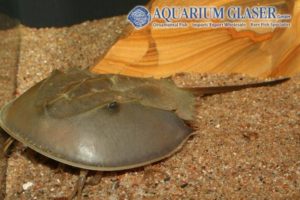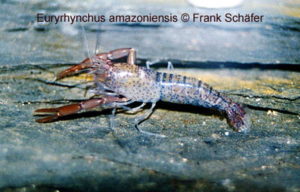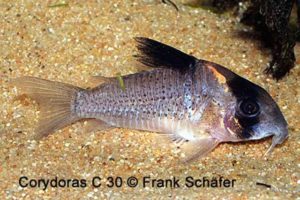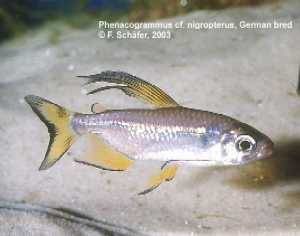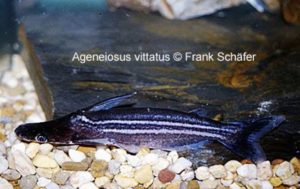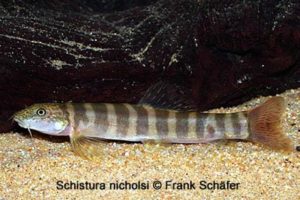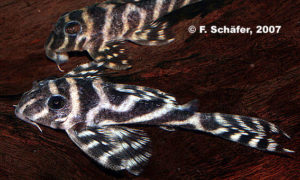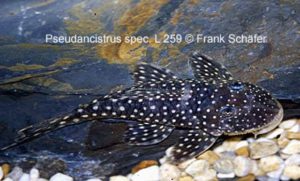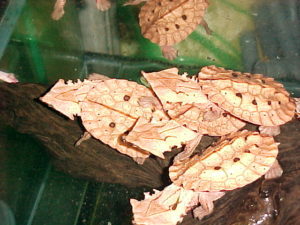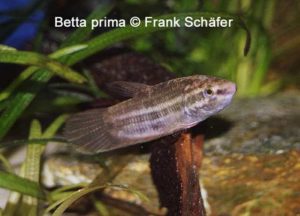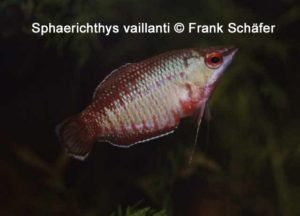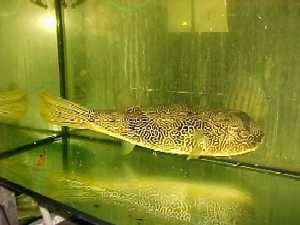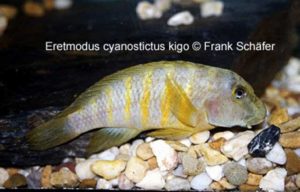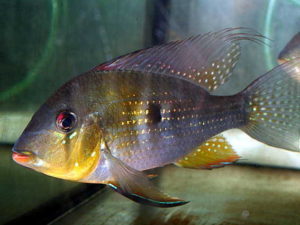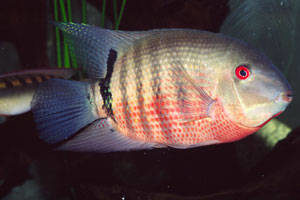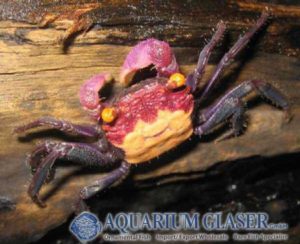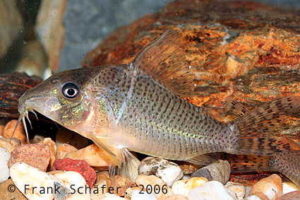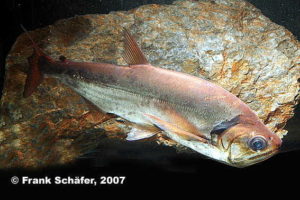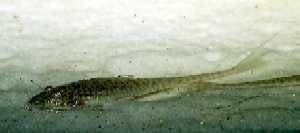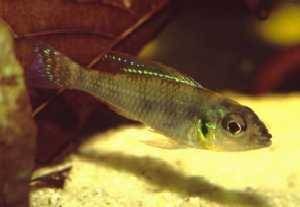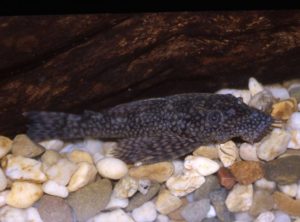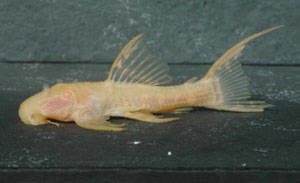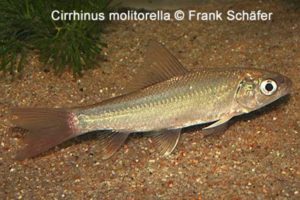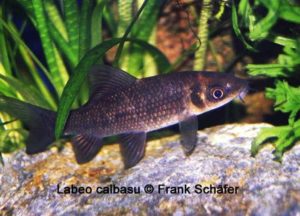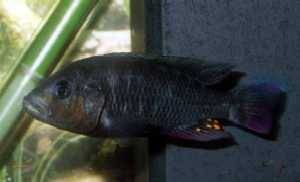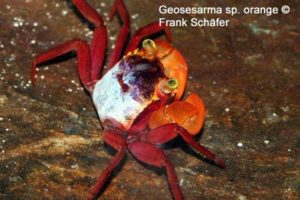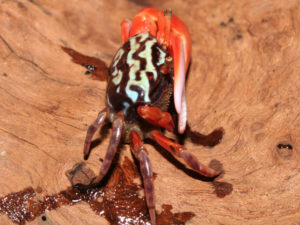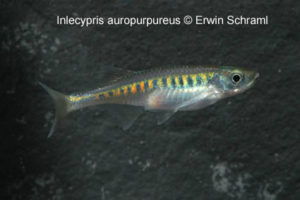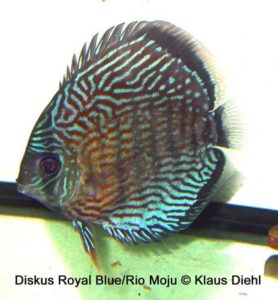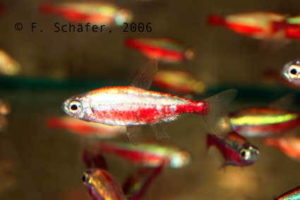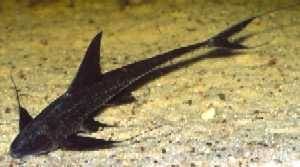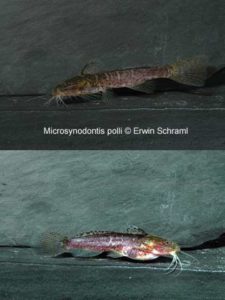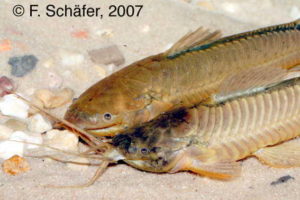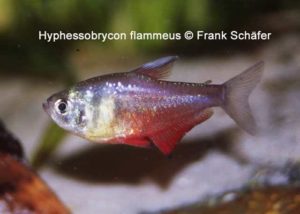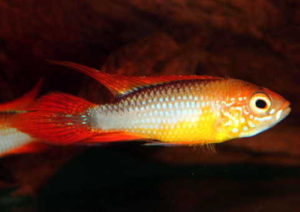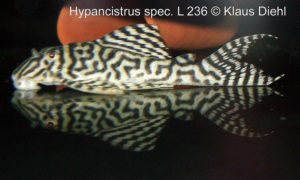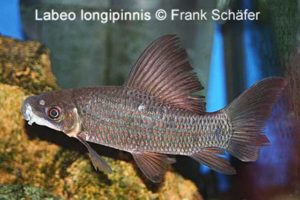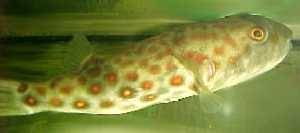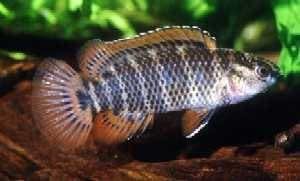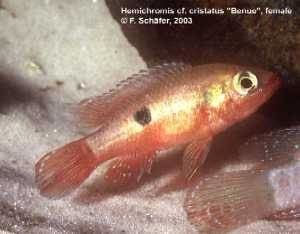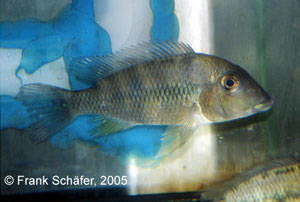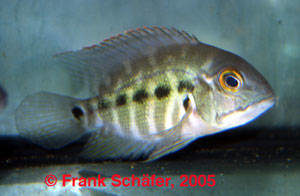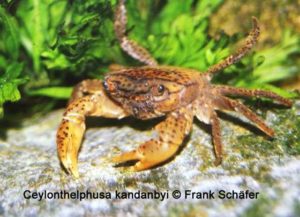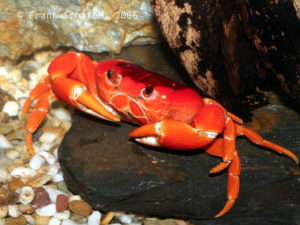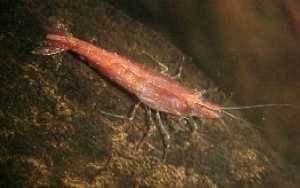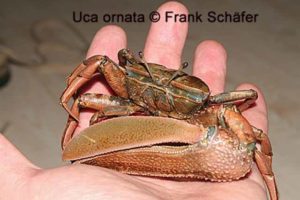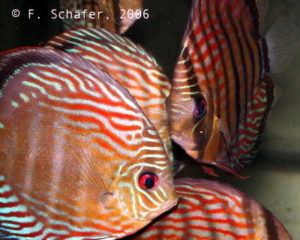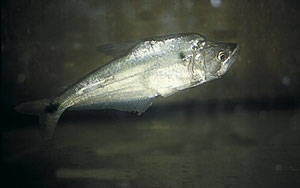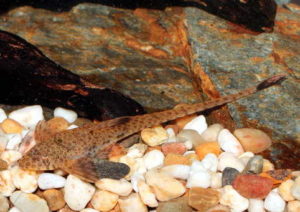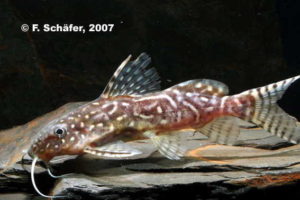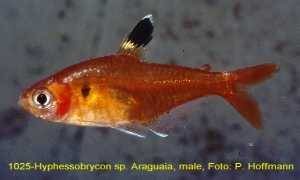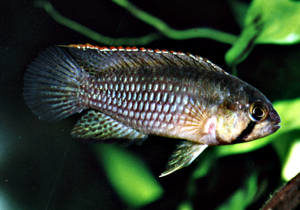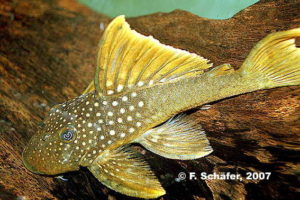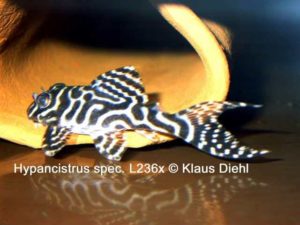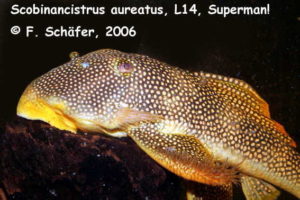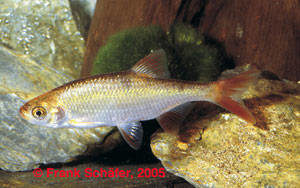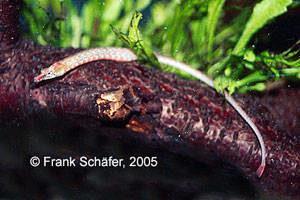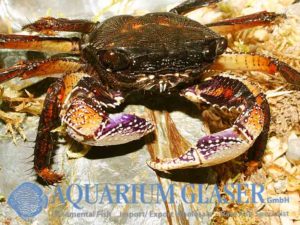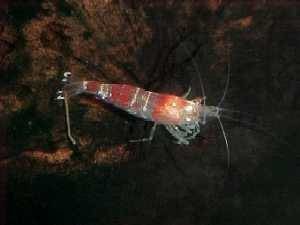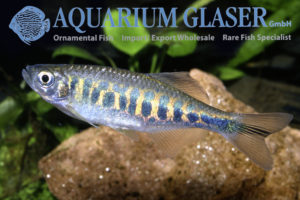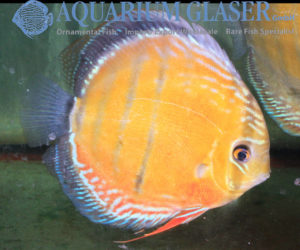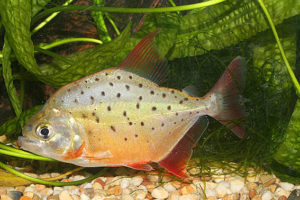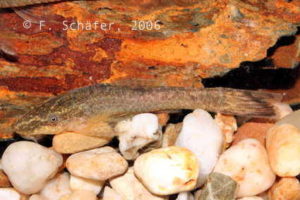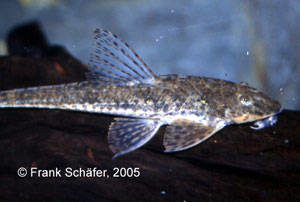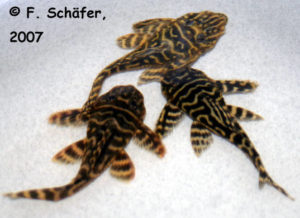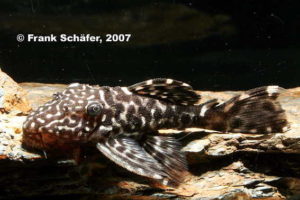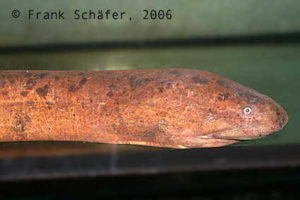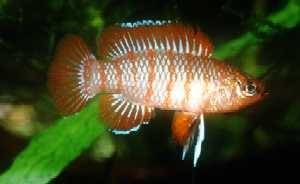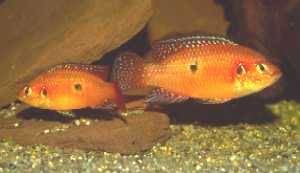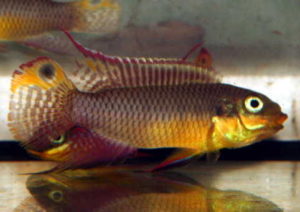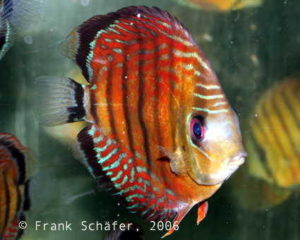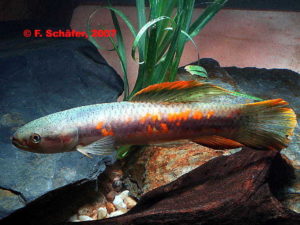The banjocat new imported from Peru immediately attract attention due to their interesting colouring in contrast to other species of the same relation circle. Therefore some animals are almost unicoloured white while other specimens mainly show some irregular black markings. The care of this species does not differ from that of other relatives of this […]
Fish Archive (3088)
-
-
Trichomycterus alternatus
One of the in the aquarium most easy to keep pencil catfishes is Trichomycterus alternatus. This species, originating from the Rio de Janeiro region, reaches an overall length of for 10cm and can be maintained in aquaria starting from 60cm length. These very shy fish, reminding in their appearance of our in Europe native Stone […]
-
Hyphessobrycon cyanotaenia, Lapis-Tetra
This tetra was introduced to us under the name of “Inpaichthys sp. Lapislazuli” in February 2002 by Mrs. Glaser-Dreyer (Aquarium Glaser GmbH). On the (Japanese) internet it is called Lapis tetra. It was imported in a bigger number of pieces without exact declaration of place of discovery. The males are growing up to at least […]
-
Hypancistrus spec. L 173
March 2005: Freshly arrived: Beautiful German breds of L 173. For the first time we can offer thereby more than a “handful” of these wonderful rare pieces. The large variability of their pattern is remarkable. The bluish glow is common in all the white of their fins. (Photo & Text K. Diehl)
-
Pelvicachromis spec. „Blue Fin“
November 2005: From Guinea the import of a still undescribed Pelvicachromis species surprised us. This species seems to mediate within the genus Pelvicachromis between P. roloffi and P. rubrolabiatus, since it carries characteristics of both species. Particularly the name giving bright blue-green dorsal fin of females is noticeable. Maintenance in pairs is appropriate, in larger […]
-
Gymnogeophagus meridionalis
If you search for a Cichlid for a society aquarium (120 l and up), G. meridionalis is almost unrestricted recommendable. Being a all eatingfish, it accepts every imaginable food, getting only approx. 10-12cm it is not growing too big and it also shows really beautiful colours. Besides it is not choosy regarding the water condition […]
-
Satanopera acuticeps
Normally the durable care of Satanopera acuticeps is only possible in soft and sour pH-value. But as it was finally successful to breed this eartheater inside the aquarium, it could be that the bred ones are easier to keep and even easier to breed. So far the breeding was possible furthermore only in soft (< […]
-
Carcinoscorpius rotundicauda
Horseshoe crabs are rightfully described as living fossils, because their ancesters populated the warm flat seas about 500 million years ago.The description of the horseshoe crab is misleading because their next relatives are arachnids and not the crabs. The Moluccan-horseshoe crab that is being presented, comes from southeast Asia and lives in coastal ranges from […]
-
Euryrhynchus amazoniensis
April 2006: Now available again: Euryrhynchus amazoniensis a rare shrimp species from South America. The delightful pattern of points and stripes on their body justifies its English name Peru Zebra Shrimp. For a long-lasting maintenance the only 3 cm large getting species needs low pH values and soft water, since otherwise a certain susceptibility against […]
-
Tanichthys albonubes „Gold“
Tanichthys albonubes “Gold” is a selection of the well-known White Cloud or White Cloud Mountain Minnow. They were imported since the end of the 30's of the past century and were called at that time “Working Man's Neon” or the “Poor Man's Neon”. This referred on the one hand to its attractive colouring, otherwise it […]
-
Corydoras sp. C 30
Corydoras C 30, a scientifically still not described species, originates from the area of the Amazon delta (Federal State Amapa) in Brazil. In its appearance it reminds of Corydoras melanistius a further north in Surinam and Guyana occurring species. Like all Corys C 30 should be held not in a to small group (5 – […]
-
Phenacogrammus cf. nigropterus
This new African tetra, presented by Dieter Bork in “Das Aquarium” 12/01 as “pastel-congo-tetra”, comes from Lake Maindombe (also known as “Lac Leopold II”) in the Democratic Republic Congo (Zaire). Ornamental fish breeder Winter was able to multiply them in a bigger number of pieces. The fins of the males are pulled out beautifully and […]
-
Ageneiosus vittatus
July 2002: For the first time we could import Ageneiosus vittatus from Peru. Slopehead catfish of the genus Ageneiosus are particularly noticeable by its strongly flattened head. These predators can reach an overall length of 30 cm. For the maintenance large basins are necessary. A dark bottom, some stones and bogwood should be brought in […]
-
Schistura nicholsi
To an unusually large about 200 species comprehending genus belongs Schistura nicholsi the Redtail Zebra Sand Loach. It originates from the Mekong basin in Thailand and Laos, where it inhabits fast flowing waters on a stony ground. This is to be considered during its aquarium maintenance. In order to ensure a high oxygen content and […]
-
Hypancistrus spec. L 173 Bred
March 2007: Freshly arrived: Beautiful German breds of L 173. For the first time we can offer thereby more than a “handful” of these wonderful rare pieces. The large variability of their pattern is remarkable. The bluish glow is common in all the white of their fins. (Photo F. Schäfer, Text K. Diehl)
-
Pseudancistrus spec. L 259
Pseudancistrus spec. L 259 originates from the surrounding of the city Pimental at the Rio Tapajos. As all Pseudancistrus species the males of L 259 show a characteristic “beard” of Odontodes (dermal teeth) during the spawning season. Contrary to the popular Hypancistrus species L 259 are vegetarians. Therefore Zucchini, cucumbers and further vegetables should be […]
-
Chelus fimbriatus
June 2006: Freshly arrived and very beautiful. From South America reached us few Mata matas. Their in jungle waters protruding camouflage lets it appear remarkable and bizarr in the aquarium.(Photo F. Schäfer, Text K. Diehl)
-
Betta prima
Betta prima originates from South East Thailand and Cambodia and is a member of the Betta pugnax group. They are found foraging along the dense vegetation of brooks, swamps and calm rivers. B. prima is a small species, they can reach the size of about 6 cm. They like well planted, and since they are […]
-
Sphaerichthys vaillanti
Sphaerichthys vaillanti is probably the rarest and most desired species of the Chocolate Gouramies. Their origin is Kalimantan the indonesian part of Borneo. Since they are black water inhabitants, the water equivalents should be adapted in the aquarium to it. This species does best in peat filtered water. Water must be changed often, and a […]
-
Tetraodon mbu
April 2002: Yesterday we received from the Republic of Congo, this beautiful Tetraodon mbu, the real congo-puffer. We got this item in this huge size never before.The maximum size cited in the literature is nearly 70cm. It is astounding how individuals differ in their behaviour: there are shy and also agressive ones. More details you […]
-
Eretmodus cyanostictus „Kigoma“
Eretmodus cyanostictus is among the group of cichlids called gobies. Gobies only occur naturally in the surge habitat of Lake Tanganjika, which is the upper meter of the water at the shoreline. They unique in that their swim bladder is non-functional, meaning that when they’re not swimming, they drop to the bottom like a rock. […]
-
Acarichthys heckelii
January 2007: At present we can offer particularly beautiful Acarichthys heckelii from the region around Santarem. These fish are characterised by an intensive yellow colouring of the body. It forms a beautiful contrast to the red eyes and their magnificent fin rays. Acarichthys heckelii has a large area of origin along the Amazon and the […]
-
Heros severus
Despite the fact that Heros severus is the type species of the Heros genus, this species is the most uncharacteristic representative of this group. This is mainly caused by its reproducing behaviour, which is mouthbreeding and untypical for Heros, because they are all substrate breeding. Also the coloration is different from the other members of […]
-
Geosesarma sp. VAMPIRE
March 2006: They are among us. Fortunately only in a small number: Vampire crabs! With a close look the horror will pack you, remind the ends of its shears very strongly of the carnassial teeth of vampires. At night one would like to meet them with their shiny red eyes in no case. Now in […]
-
Barbus jae
The Jae barb is one rarely out of central Africa imported dwarf barb. With scarcely four centimeters of length they attained full growth and show an attractive red coloration on their fins. The red hue of the fins is more weakly pronounced with the females; their body exhibits predominantly beige-brown tones. In addition the females […]
-
Corydoras sp. C 71
August 2006: With Corydoras spec. C 71 we could import a further rare species from Brazil. They originate from the Rio Arua in the Federal State Para. With a final size of 6 cm they belong to the medium sized Corys. The requirements for their maintenance might be the same as for other Corydoras species. […]
-
Hydrolycus tatauaia
From Peru some sabre toothed Tiger Fishes of the species Hydrolycus tatauaia came to us. For the maintenance of these impressive hunters naturally roomy aquariums (> 1000l) are needed. Young specimen can be kept in swarms, in the wild even swarms of mixed species were observed. With ageing their aggression potential rises and they become […]
-
Pseudohemiodon thorectes
This catfish coming from Bolivia, belongs to the smallest of his relatives, measuring 13 cm maximum. It is mostly getting imported by travelling aquarium hobbyists. Regarding the water condition this kind is rather adaptable, as guide values of up to 400 µS/cm and a pH-value of 7.6 were measured. Approx. 25°C are quite enough for […]
-
Biotoecus sp. „Tapajos – New“
For quite a while Aquarium Glaser imports this dwarfcichlid regularly from Rio Tapajos in Brasil. This Cichlids, which only get approx. 4-5cm can be kept in pairs in smaller aquariums from 50 ltr and up already. If the aquarium is bigger, a larger group can be brought in, but in doing so a slightly surplus […]
-
Ancistrus spec. L 111
This ancistrus, which supposedly originates from Colombia, exhibits similarities to L 89, but like L 156 has round spots arranged in a honeycomb pattern. Unlike these other two L-numbers, L 111 has a uniformly marked iris ring and light/dark grey striped pectoral fin spines. This catfish is said to grow to about 10 cm, and […]
-
Pseudoacanthicus spec. „Albino Titanic“ L 273
April 2005: Only one fish of the albino form of the well-known „Titanic Catfish“ was imported from Belem (Brazil). L 273 is normally extremely variably coloured from fish to fish. As well as splendid specimens with contrasting dark grey/yellow plus orange colouration there are also individuals that are predominantly mouse grey with black dots and […]
-
Cirrhinus molitorella
If you are interested in a larger growing fish, the mud carp Cirrhinus molitorella originating from Southeast Asia, could be the right thing for you. In the list of fishing world records it is quoted with a length by 1 m and applies in Thailand under the name Pa Keng as a strong fighter at […]
-
Labeo calbasu
Labeo calbasu the Orange-fin shark is a real king sized labeo. In its homeland (Pakistan, India, Bangladesh, Myanmar, Nepal, Thailand and South West China) it is a fish for consumption and therefore of importance in the asiatic aquaculture. With a size of up to 1m it is not a fish for the “normal” aquarium. Aficionados […]
-
Haplochromis sp. Mburo Blacky
The “Mburo Blacky” is coming from Lake Mburo in Uganda. This species is undescribed until now and grows up to 12cm. It does not dig and do not eat plants, but it is rather agressive and therefor those fish need bigger tanks (1 meter in length and up) in which they can find places to […]
-
Geosesarma sp. „orange“
March 2006: The mandarin crab, a further still undefined Geosesarma species, reached us these days from Sulawesi. It is characterised by a very intensive red-orange colouring of the legs and particularly the claws as well as bright yellow eyes. Thus it represents a beautiful coloured contrast to the last week introduced vampire crab. Whether a […]
-
Uca annulipes
May 2005: One of the most beautiful fiddler crab, Uca annulipes has been available now. Fiddler crabs, a family of 65 species, live worldwide in tropical and subtropical areas where they inhabit beaches and swamps. They reach a length of no more then 2.5 to 3 cm. The male animals have one large and often […]
-
Danio aesculapii (=Danio sp. „Pantherinus“)
These minnows originate from Burma, does not grow over 4 cm and is therefore the smallest representative of the Danio genus. But now this beautiful barb fish has been imported by Aquarium Glaser and is now available for the dedicated aquarium hobbyist. As with all representatives of the Danio family, D. sp.„Pantherinus“ is a schooling […]
-
Inlecypris auropurpureus
Inlecypris auropurpureus belongs to in Inlé lake in Myanmar occurring endemic fish species. That about 6 cm long becoming swarm fish should be held in well planted to not too small (80cm) tanks. Since they are good jumpers, young animals of 1,5cm length can already jump over 10cm high, the tanks have to be completely […]
-
Diskus Royal Blue/Rio Moju
If an increase of beauty and charisma of the at 01.02.06 introduced Diskus variant Red Inferno/Rio Moju is still possible, then by the Royal Blues originating from the same river. When first seeing these fishes I remembered the headline of an old “aquarien magazin” article. In January 1972 Eduard Schmidt Focke a famous german discus […]
-
Cheirodon spec. „Gold Neon“
At present we can offer some Cardinals of the variety „Gold Neon“. This is one of some more in the wild rarely existing colour forms of Cheirodon axelrodi. Actually it is not clear whether this colour forms are distinct species or varieties of the cardinal. At the “Gold Neon” the blue colour strip is replaced […]
-
Pterosturiosoma microps
Pterosturiosoma microps is one of the regularly imported Loricariidae from Peru, although not in bigger quantities. Even though it is more impressing in colour by its soft black-grey, it can still arouse enthusiasm by its remarkable appearance and its impressive but graceful fins. But its steady nursing is not quite easy. Whereas the acclimatization probably […]
-
Microsynodontis polli
Microsynodontis polli is one of three poorly documented pygmy Synodontis species, the other two being M. lamberti and M. batesii. They origin from Western to Central Africa, M. polli is reported for the upper Niger in Guinea and Liberia. Their maintenance is no problem as long as the water is soft and slightly acidic, although […]
-
Callichthys spec. NEW
From southern Brazil we could import a probably new Callichthyid catfish species. The sexes can be easily differentiated on the basis the dark pattern at the head of the females. In their homeland they inhabit diverse waters types. As accessory air-breathers they can move over land if it gets necessary to reach other waters. Their […]
-
Hyphessobrycon flammeus
The Flame Tetra, Fire Tetra, or Von Rio Tetra is a well established aquarium guest. Its origin is the proximity of Rio de Janeiro in Eastern Brazil, where it occurs in coastal rivers. As swarm fishes they need the society of conspecifics. Since the optical impression of the observer depends on the swarm size, it […]
-
Apistogramma agassizii „Fire Red“
September 2006: Few days ago we received a delivery of fishes from a well-known German breeder. The here introduced Apistogramma agassizi „Fire Red “increases the heartbeat of each Apistogramma fan. The strong red of the caudal -, dorsal – and anal fin forms a fantastic contrast with the blue-yellow body colouring and a dark longitudinal […]
-
Ancistrus spec. L 352
Our photo shows a pair of Ancistrus spec. L 352, one with 6 – 7 cm very small remaining loricariid from the Rio Iriri. In the view from above the different body forms can easily be be recognized. This and the characteristic beard of the males makes a differentiating of the sexes quite easy. As […]
-
Hypancistrus spec. L 236
„Simply the Best “: Some days ago we could import some of this beauties. With a size of approx. 10cm the white of the here illustrated male shows a fantastic intensity. It seems that one of imported fishes is a not less beautiful female, and so we hope to be able to offer some days […]
-
Labeo longipinnis
december 2005: For the first time in Europe we can present Labeo longipinnis from the Congo River to you. This about 30 cm long growing Labeo is not noticeable by a particularly spectacular design or colour. Due to its lively manner, beautiful form and fins it can become nevertheless a genuine “eye-catcher” in the community […]
-
Tetraodon pustulatus
TETRAODON PUSTULATUS was caught in Cross-River in Cameroon. External shape and behaviour of adult animals remind one of Tetraodon mbu. The maximum size is quoted with 36cm in literature. Young animals being kept together do not show any injuries so that it is safe to assume that they are not very aggressive. Tetraodon pustulatus has […]
-
Badis corycaeus (formely: sp. Putao)
This new, brown-red Badis was imported from the borderland of Myanmar and China. They can can be kept even in cooler temperatures and are easily satisfied. Also bred ones are already available. (Photos & Text D. Bork)
-
Hemichromis cf. cristatus „Benue“
This beautiful cichlid comes from the Benue-river. At least the females grow up to 5cm, the males reach their maximum size with 7cm. Among themselves they are peaceful and they also can be kept with other fish. But there is a slightly rough behaviour, which is typical for all red cichlids. But much less than […]
-
Geophagus crassilabris
Very large animals, up to 20 cm, came to us from Colombia. These beautiful fish came as well from the Rio Chacu. These eartheaters live in nature in a habitat of moderately flowing streams and rivers. Remarkably for this group of eartheaters is the way they breed their eggs, not as normally in the throat […]
-
Hoplarchus psittacus
This, by specialised hobbyists of large South American cichlid, well known species is only very rarely offered to the public. Our animals were imported from Columbia. The best way to take good care of these beautiful cichlids, which can grow up to 40 cm, is to keep them in large fish tanks with plenty of […]
-
Ceylonthelphusa kandanbyi
The leopard crab Ceylonthelphusa kandanbyi represents an attractive addition to the offered crustaceans. This 1999 scientifically described species originates from Sri Lanka where it is found in the Bentota river system. According to statement of our supplier the animals were caught in the proximity of Mathugama city a town in the western part of Sri […]
-
Gercarcinus ruricola
This splendid land crab (Halloween-Crab, Gercarcinus ruricola) occurs in two colour variants, specifically with red or white base coloration. The colour variation involves both sexes. A mixed pair lived together in harmony for several weeks in my terrarium. These creatures are essentially vegetarian, but will occasionally take frozen foods intended for aquarium fishes, eg bloodworm. […]
-
Neocaridina sp FIRE/CHERRY
July 2004: Yesterday we got a limited number of this beautiful shrimp, which belongs to the family of Neocaridina. This type was imported one year ago, but also only in small numbers. They do not demand special water parameters and can be easily fed with common fish food. They can be kept in community tanks, […]
-
Uca ornata
January 2006: For the first time in Germany: The fiddler crab Uca ornata. We are proud to introduce this new species to the pet market. We got only few animals from Ecuador, hope however for further imports of this species. Further information for the maintenance of this at the Pacific coast from Ecuador to Nicaragua […]
-
Danio choprai
From Myanmars rivers and brooks origins Danio choprai the Glowlight Danio. With a length of 4 cm they have already attained full growth. With them as with many swarm fish the effect on the observer rises with the swarm size, a group of 30 animals is always impressing. Glowlight danios are good to keep and […]
-
Labeo barbatus
As a further new import from the Congo we can present you Labeo barbatus. It is a about 60 cm growing representative of the genus Labeo, which is represented in the Congo River with at least 34 species. In its habitat it lives in sections with strongly flowing waters. About its behaviour in aquaria little […]
-
Diskus Semi royal, Rio Moju
Like the introduced before Discus from the same area (Rio Moju) the “Semi Royal” variant shows a strong red coloration at the seam of their body and their fins. With them the wave pattern is nearly continuous distributed over the entire body. (Photo F. Schäfer, Text K. Diehl)
-
Cynopotamus atratoensis
Only three of these predatory characins found their way to Aquarium Glaser. This group of characins form the subfamily Cynopotaminae within the family of real American characins (Characidae). The representatives of this subfamily are relatively large fish, which can reach a total length between 15 and 30 cm in adulthood. Cynopotamus have large mouth openings […]
-
Rineloricaria melini
As a further german bred rarity we can offer Rineloricaria melini at present. Our specimen of the probably most attractive Rineloricaria species have with 9 – 12 cm length already attained full growth and are of outstanding quality. Their origin is the area of the Rio Negro where they live in black water biotopes. Like […]
-
Synodontis angelicus
From the Katanga province of the Congo we could import some partly striped specimen of Synodontis angelicus. Formerly these forms were regarded as the subspecies Synodontis angelicus zonatus, today they are considered however as a color variant of the species. In any case they are very decorative and should not be missing in Congo basins […]
-
Hyphessobrycon haraldschultzi (= spec. „Araguaia“)
Red fish always attract interest amongst hobbyists, especially the intensively red coloured ones. Five years ago when we received the first animals of this tetra by the name of “Hyphessobrycon serpae – the real one” (wildcaught from Rio Araguaia), we were immediately enthusiastic, too. At first sight (still inside the transport bag) these tetras looked […]
-
Nannacara sp. Essequibo
This fish was caught in October 2001 in a blackwater-river nearby Rockstone/Guyana. It is a peaceful fish which only grows up to 60mm. The males are more elongate than the females and have clearly visible spots in the dorsal and caudal fins. Water of following parameters was used for breeding and keeping them: 5°dGH, pH […]
-
Baryancistrus demantoides L 200 High Fin
From Colombia we could import expressed beautiful L 200 High Fin. Now we have very attractive partially completely yellow colored specimen of the species Baryancistrus demantoides in stock. They will get only about 15 cm long and remain thereby substantially smaller than the also with the number L the 200 labeled Hemiancistrus subviridis. Compared with […]
-
Hypancistrus spec. L 236x
November 2006: At Christmas we would like to present a star at the catfish heaven. We can offer some offspring of the queen imperial zebra Hypancistrus spec. L 236x, a beautiful and very looked for species. They come from a German breeder, who had the luck that the two from us imported animals formed a […]
-
Scobiancistrus aureatus L 14
December 2006: Last week received we a really impressive, male Scobiancistrus aureatus. With a length of about 30 cm it might be attained full growth. The strong spines on the gill cover (Interopercularodontodes), as well as on their pectoral fins are remarkable. As most L-catfishes from the Rio Xingu they like warmer waters, for their […]
-
Scardinus erythrophthalmus Golden
March 2004: Just in time for the pond season this very attractive variety of the Rudd (Scardinus erythropthalmus) came to us. It is an excellent ecological algae destroyer for your garden pond. The Rudd is an endemic species for the whole of Europe and Asia up to the Aral Sea. It is a friendly schooling […]
-
Enneacampus ansorgii
The small freshwater pipefish originates from Western Africa, from Cameroon to Gabun and in the Zaire- and Ogowe River. These fish inhabit freshwater as well as brackish water habitats. Addition of sea salt (1-2 teaspoons per 10 litre of water) will therefore increase the vitality of these fish. This species, but actually all freshwater pipefish, […]
-
Tahuantinsuyoa macantzatza
The unpronounceable from the Incas empire. So an article about Tahuantinsuyoa macantzatza the Inca Stone Fish could be titled. After fearing over years that they had become extinct, we succeeded to import a larger number of them at the beginning of 2003. For the first time we can offer now both: very beautiful wild caught […]
-
Goniopsis pelii
June 2006: The mangrove crab Goniopsis pelii reached us from the Atlantic coast of Africa. Their orange and blue coloured claws are very remarkable. They owe their name to the mangrove woods where they naturally occur. This by water and land affected biotope has to be reproduced in the terrarium, since they need both habitats […]
-
Neocaridina sp RED CRYSTAL SHRIMP
December 2002: Here we have it: german bred red crystal shrimp. We only got a few pieces, but we expect a limited quantity in the near future. This shrimp of the family Neocaridina is easy to keep and can be kept with not too big growing fish in a community tank (Photo F. Schäfer, Text […]
-
Uca tangeri
The eastern Atlantic from Portugal to Angola, is the origin of the fiddler crab Uca tangeri, where they inhabit sand and mangrove coasts. The to an enormous size grown major claw of the males is remarkable. It is used for attracting the females and to the fight between rivaling males. In their periodically flooded habitat […]
-
Devario pathirana
We received this endemic kind, which was only specified in the late 1980s, from Sri Lanka. Devario (formerly: Danio) pathirana exclusively occurs in a small area in Sri Lanka. Their final size is 8cm, they are easy to keep and their breeding is no problem either. This species is as demanding as the far […]
-
Diskus „Nhamunda rosé”
Nhamunda Rosé is the trade name of a strain of the brown discus Symphysodon aequifasciatus axelrodi originated in the Rio Nhamunda (northern influent of Amazon, west the city Alenquer). Now again some Nhamunda Rosé are available. Characteristic for this variety is the partially laminar high red part of the brown primary colour. Thus they are […]
-
Pristobrycon maculipinnis
April 2006: This week we got some very nice Pristobrycon maculipinnis. This rarely traded and in the fish keeping hobby almost unknown species is characterised by intensive red colored fins, as well as a pronounced examination of black markings over the silver shining body. Maybe it is the most attractive of all Piranhas, it originates […]
-
Hisonotus notatus
July 2006 From southeast Brazil we could import some rare pieces from the relationship of the popular Otocinclus species. In its homeland Hisonotus ornatus inhabits with weeds infested waters. It may not be kept too warm. 24°C probably represents the reasonable upper limit. The requirements for their maintenance do not differ from those of the […]
-
Rineloricaria sp. „Colombia“
A remarkable species which came in in one of our import from Colombia. These fishes also originate from the Rio Chacu in the northern tip of the country. Because of the many bristles of the male this species has been falsely determined as Rineloricaria latirostris. A comparison with the pictures (see Mergus Catfish Atlas Part […]
-
Hypancistrus spec. L 340
Freshly arrived from Colombia: the Megaclown L 340. We can offer one of the most beautiful and at the same time most variable Hypancistrus “species” in very good quality. The animals already reached maturity, so that the outstanding contrast should remain. In their requirements for maintenance they do not differ from their Brazilian cousins, warm, […]
-
Leporacanthicus sp. „NEW“
April 2007: We received a particularly beautiful easter surprise this week from Colombia. The representative of the genus Leporacanthicus illustrated here is probably the first and only specimen on the market. It reminds of the in the Orinoco occurring L 240 and L 241, as well as of Leporacanthicus cf. “Venezuela”. But its white spots […]
-
Synbranchus marmoratus
As a beauty in the conventional sense Synbranchus marmoratus can not be chracterised, but even the extraordinary has its attraction. At the moment we can offer beside swamp eels in „normal“ sizes a giant of approximately 1 m length. Of course a predator of this size should not be kept together with small „food fishes […]
-
Dario dario
This species, which became well-known as Badis sp. SCARLET is still enjoying great popularity. This dwarf badis can be kept very well along with dwarf rasboras. It is is quite easy to keep and to breed, which was succesfully done several times already. (Photos & Text Dieter Bork)
-
Hemichromis sp. Bangui
Red Cichlids of the species Hemichromis are generelly regarded as aggressive, but this prejudice is based on past years, when 160 ltr tanks were considered to be bathtubs and you mostly had to be satisfied with 60 ltr aquariums. To keep them in pairs, an aquarium of this size is in fact sufficient for Hemichromis […]
-
Pelvicachromis taeniatus „Lokundje“
From Pelvicachromis taeniatus are numerous variants and local forms existing in the western parts of Africa. One of the most beautiful variants is surely Pelvicachromis taeniatus „Lokundje “(a river in the south of Cameroon). At the moment we can offer very beautiful breds from the same breeder as the already introduced Apistogramma agassizi „Fire Red […]
-
Cherax lorentzi
In its shining armour Cherax lorenzi reminds of a medieval knight, who is on its way to the tournament. With a size of 12 cm it can be kept very good in aquariums starting from 100 cm length. Contrary to some of its relatives Cherax lorenzi does not seem to harm other tank mates. Therefore […]
-
Diskus „Red Inferno/Rio Moju“
In the following pictures you see some impressions from our discus installation. Seldom could we offer a so large selection on magnificently coloured, perfectly acclimatized Discus. The animals originating from different areas are even in our facility hardly to exceed in colour splendour. Since all of them attained full growth, breeders can fast extend their […]
-
Erythrinus erythrinus
June 2007: Last week we imported from Peru a small amount of probably the most beautiful of all wolf characins. A big advantage of Erythrinus erythrinus is it’s size, that stays with about 25 cm in a tolerable area. It doesn’t have excessive claims with water-chemistry. In it’s homeland, it lives next to small streams […]





